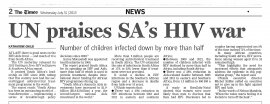

HIV reporting needs to be concise, captivating & cover crucial issues
Maxine Birch
8 August 2013
It is critical that HIV reporting strives to be topical, innovative and interesting in the context of ‘HIV fatigue’ and a decline in the perceived newsworthiness of HIV.
Last week The Star (31 July 2013) and The Times (31 July 2013) focused on a United Nations report, '2013 Getting to Zero: HIV in Eastern & Southern Africa'. The articles reported on the glowing review South Africa received for the “extraordinary progress” it has made in its response to HIV.
Whilst it is important to point out the substantial headway being made in response to HIV, therefore keeping HIV in the news and on the public’s radar, it is necessary to do so in a way that keeps the public’s attention and focuses on the key issues at hand.
One of the critical concerns raised by the UN report was the lack of adequate treatment programmes for children living with HIV. The UN report states that ART paediatric coverage has shown very little improvement between 2009 and 2012 and is an issue that has been largely overlooked.
HIV management in children has recently been identified as an area in need of attention and one of the next big issues to be tackled in addressing the epidemic. HIV coverage should, where possible, reflect these priorities.
The Star’s article mentioned the low ART coverage among children but did so briefly at the end of a long piece that tended to slide into listing statistics, at which point many readers may have lost interest. Given that we live in a society characterised by ‘AIDS fatigue’ and disillusionment with the news in general, using creative, innovative and interesting journalism to get to the crux of the matter when reporting on HIV is vital.
The article in the Time’s on the other hand, kept it short and to the point using bullet points to highlight important information. However it also overlooked the core issue of paediatric HIV, even though the strapline centred on it.
This disconnect could have happened when the story was edited, highlighting the importance for sub-editors to connect the article to the headline or strapline in a way that remains true to the content.
HIV has a lingering death and disaster legacy which still effects perceptions of the newsworthiness of HIV, even though it has long since been displaced by good news reporting with HIV coverage tending towards success stories. Due to this, it is important for coverage on HIV to be concise, captivating and to cover the crucial issues.
The Star and The Times should be applauded for conveying HIV information from the UN report to the public.
But by relegating important HIV information to a small paragraph at the end of a long report or failing to raise important topical issues, the media runs the risk of losing the reader’s attention and missing out on a prime opportunity to communicate HIV-related information and bring the issue to the public’s attention. At worst lacklustre coverage could reinforce and perpetuate HIV’s perceived status as a less newsworthy topic.
blog comments powered by Disqus



